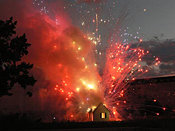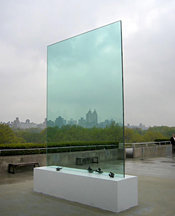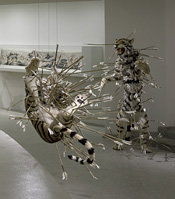Introduction
Cai Guo-Qiang is a Chinese artist who has been in the limelight for decades. His unique skills in artwork have led to the advancement of his signature in most events. Cai discovered the importance of gunpowder in artworks. He has utilised gunpowder in most of his artworks. He has also experimented with explosives in his unique career.
He was drawn to gunpowder because of its myriad of uses. Moreover, he has a repertoire of social projects as well as installations. His works are mainly drawn from Eastern philosophy. This paper will explore Cai’s artworks as well as their influence in the global world (Lufty 144–147).
Cai Guo-Qiang
Cai was born in China’s Fujian province in 1957. His father was a painter and a historian. During his childhood, Cai lived in Guangzhou city, which is in Fujian province, the place of his birth. His father worked in a bookstore, which exposed Cai to Western literature. This also introduced him to Chinese forms of art at a tender age. He went on to train at the Shanghai institute of Drama. Since then, Cai has been revolutionary in his works (Friis-Hansen 144).
However, it is important to note that his works have sometimes been politically charged as well as scholarly. His use of gunpowder was influenced by the need to oppose suppression experienced in Chinese artworks and social climate. Moreover, he wanted to nurture spontaneity in his works. His exploits in gunpowder use started in 1986 while he lived in Japan. His inquisition on gunpowder eventually led to use of explosives in his artworks. This epitomised his works in extraterrestrials (Artsy 1).
His works in Japan continued until 1995. His works were considered wildly poetic and ambitious since they tried to provide a link between his audience and the large universe surrounding them. His works, which are largely drawn from Eastern philosophy, encompassed various mediums such as video, drawings, and performance art.
Feng Shui’s philosophy utilised by Cai has been site-specific in its cultural and historic aspects. Cai has made several large-scale installations in the process with a view on contemporary issues being top of his agenda. His prominence thrived in Japan largely due to his exemplified works.
Since 1995, he has been living in the United States (New York). In his Career, Cai has received several prizes. Some of which include selection as a finalist for Hugo boss prize in 1996 as well as the 48th Golden Lion of 1999 (Venice Biennale), among others (Art21, Inc. 1).
In addition, he won several other awards including being best in Monographic museum show which featured his solo exhibition at MOCA. Moreover, he also won the best single work at the international association of arts critics through his exhibition featuring Inopportune. Variously, he has also won awards at the Hiroshima art prize, and the Fukuoka Asian culture prize, among others. Cai has performed exhibition in most museums around the world.
He has influenced artworks in most parts of the world, especially in Asia. In the process, he has also gained prominence on his stance against oppression, history, and culture. His socialist skills have also been observed in most of his art works. Among his exhibitions, include “inopportune” in MASS MoCA, “Traveler,” and “Transient rainbow,” among others.
In the process, his many artworks have been exhibited in many museums around the world. This has ensured that he remains in the limelight for decades. However, it is important to note hat his critics have also tried to confine him to the Eastern culture (Zaya, Friis-Hansen, and Takashi 17).
His artistic works
His works involved use of gunpowder, among others. Use of gunpowder began in the 1980s through paintings and drawings. He used these to make his project for extraterrestrials. The main feature in this was his 600kg gunpowder, which was done along China’s Great Wall. Cai had many artworks in his career.
His works are drawn from various narratives, materials, traditions, and symbols. His early works were made while he was a student. These comprised of abstract patterns in burnt gunpowder and oil. This qualified him to gain entry into the experimental ferment, which he left when he moved to Japan.
His first major project was the “Project for extraterrestrials” in 1990. This project comprised of large fireworks with extensive gunpowder blazing. It covered large buildings and landscapes. These projects were done in many parts of the world. It is important to note that they were site-specific. An example of this was done along the Great Wall of China, which spanned 10 kilometres in 1993 (Bradley, Yuko, and Robertson 67).
He explored the properties of gunpowder before deciding to experiment mass scale explosives. He also utilised this to create his signature, which was known as “explosion events.” The dragon like pattern created burned for around 15 minutes after being lit. This was done to signify China’s mythological heritage and imperial.
The next grand installations were known as the “inopportune” installations. Both stages were installed at the MASS MoCA. This was duplicated in New York (Guggenheim Museum) in 2008. These were aimed at reflecting on unrelenting dilemmas surrounding cultural, violence, beauty, heroism, terrorism, and religious conflict, among others.
Other artworks included “project to extend the Great Wall of China by 10000 meters,” which was done in 1993 at China’s Jiayuguan City; “the earth has its black hole too,” which was done in 1994 at Japan’s Hiroshima. Still others include “flying dragons in the heavens,” (1997 at Denmark’s’ Humblebaek).
In addition, other solo artworks included “Traveler” (2004 in Washington DC), “Transient rainbow” (2002 in New York), “I want to believe” (2008 and 2009 in New York and Bilbao respectively), “Transparent Monument” (2006 in New York), “Sky ladder” (2012 in California), “Saraab” (2011 in Doha), and “Light Cycle” (this was a project in New York), among others. In essence, Cai exhibited many projects in is artworks. Some of the pictures are as shown below (Davis 1).




Theories and ideas
Cai has done several works of art. His inspiration has ensured that he remains in the limelight in most of his solo works. His artworks were mainly centred on three themes mainly extraterrestrials, ephemera and explosions. His proximity to Taiwan was also influential in his artworks as he observed frequent events involving use of artillery and gunfire.
His homeland was also embroiled in superstitions because of the many religious sects such as geomancy, Daoism, Buddhism, among others. In addition, other influences included classic of change, incense, and firecrackers. Most of his works were inspired by Maoist socialist concepts. This is evident in his gunpowder drawings, which draws upon Mao’s tenets on creating nothing and destroying nothing. He alludes to this when he says that Mao influenced most of them (artists) with his utopia sentiments and romance.
His works were also politically charged, as he tried to confront the socialist movements. However, his works were also scholarly with an insight into artistic ideas. Still, his work was also a representation of Chinese traditional culture and Eastern philosophy. In essence, his theories and ideas were influenced by traditions, eastern philosophy, political state, and religion. However, his main contributions were on extraterrestrials, ephemera, and explosions (Jones 1).
Effects and influence in China, Community and Globally
Cai’s works have had great influence and significance to communities, China, and the world at large. For instance, his project in China’s Great Wall symbolised the country’s ideals and mythologies. In addition, his fireworks in the Chinese Stadium during the Olympics also portrayed his influence to Chinese community and the world at large.
He has always paid tribute to conflicts and massacres in the world. This has enabled him to be iconic as an artist with great influence in the world. In essence, he has worked to ensure that his artworks are in accordance with contemporary issues in the world. Therefore, he has been relevant in globalisation and diversity of cultures. His works in his native community has also portrayed the power and influence he has had in his community (Joselit, Kwon, Munroe, and Guo-Qiang 45).
Modernity and Chinese in his work
Cai’s works started with an ancient outlook of gunpowder/oil paintings and drawings. This was seen as a Chinese outlook. In fact, since he borrowed his ideas from the Chinese culture, this was understandable. However, modernism crept into his work once he discovered the properties of gunpowder.
His projects were intense and were considered extraterrestrial because of their uniqueness. Since then, modernity surfaced in his artworks and this has only soared. He has been able to bring innovation into his artworks. However, this has come with its challenges. His artworks have been incredibly expensive because of modernity in them.
However, he has maintained Chinese artistic and traditions in his works. For instance, his famous artwork “I want to believe” has been thought to be inspired by traditional belief. In addition, the fact that he uses Mao’s tenets in his work confirms his socialist principles, which attach him to Chinese traditions (Guo-Qiang 1).
Criticism on his work and his response to them
Despite his excellence, several critics have shown scepticism in his works. Other artists such as Jonathon Keats, among others have referred to him as pragmatic in his criticism of the republic of China. However, Keats believes that Cai is only good to China but not to the best of the world. He thinks that Cai promotes socialist culture, which is irrelevant in Western world.
However, Cai says that his artworks are in response to various conflicts around the world, which includes the United States (11th September attack). Cai believes that his contribution to artwork is for the whole world. He therefore tries to shun violence through beauty and joy in his artworks.
Moreover, he uses material fuels in conflicts to portray his artworks. Besides, other critics have accused him of having superficial ideologies based on his actions especially as seen in China and Sudan. Some critics have also accused him of being material and attention seeker to an extent of leaving his ideologies. However, he denies all these, instead focusing on the belief of changing the world (Keats 1).
Aims and notion behind his works and his views
In his “Project for extraterrestrials,” Cai draws his inspiration from his belief in the need for replacement of earthly conflict with higher perspective. In this regard, he uses gunpowder, which brings conflict and destruction to portray a system of joy and beauty. It can be noted that Cai is peace loving and this is evidenced in his choice of material fuel of violence (gunpowder) to bring peace, beauty and Joy. His works were also aimed at attaining freedom of artwork in a suppressive social climate in China that controlled artistic tradition.
This portrays his pursuit of justice and uniqueness in artistic work. He is also influenced by superstition and religious sects like Daoism. This shows his strong viewpoint on religion and culture. Moreover, China’s founder Mao had a great influence in him, which he concurs. This shows his socialist principles as drawn from Mao, whom he describes as having utopia sentiments and romance (Dawei and Guo-Qiang 11).
Conclusion
Cai is one of the world’s most decorated artists. He was born in 1957 in China’s Fujian province. China’s fundamentalist Mao influenced his socialist principles. In addition, His father influenced his skills in painting and drawing. Moreover, his western literature aspects were drawn from his father’s work place, a bookstore that contained western literature as well as Chinese artistic works.
It can be noted that he was heavily influenced by the need to replace earthly conflict with a higher perspective. Cai was exemplary in his artworks. His solo exhibitions like inopportune, fireworks and MoCA, among others, highlight his illustrious career (MOCA 1).
Works Cited
Art21, Inc. Cai Guo-Qiang: About Cai Guo-Qiang. 2012. Web.
Artsy. Cai Guo-Qiang: Chinese, Born 1957. 2013. Web.
Bradley, Fiona, Yuko Hasegawa, and Robertson James. Cai Guo-Qiang: Life Beneath the Shadow, Edinburgh: The Fruitmarket Gallery, 2005. Print.
Davis, Ben. Cai Guo-Killer. 2013. Web.
Dawei, Fei and Guo-Qiang, Cai. Cai Guo-Qiang, London: Thames & Hudson, 2001. Print.
Friis-Hansen, Dana. “Cai Guo-Qiang at the Iwaki City Art Museum.” Art in America. 82.11 (1994):144. Print.
Guo-Qiang, Cai. Cai Guo-Qiang: I Want to Believe. 2008. Web.
Jones, Jennie. Directions: Hirshhorn Museum and Sculpture Garden. 2013. Web.
Joselit, David, Kwon Miwon, Munroe Alexandra, and Guo-Qiang Cai.Cai Guo-Qiang: I Want to Believe, New York: Guggenheim Museum, 2008. Print.
Keats, Jonathon. Why Cai Guo-Qiang Is Good For China And Bad For Art. 2012. Web.
Lufty, Carol. “Flame and Fortune.” Artnews. 96.11 (1997):144–147. Print.
MOCA. Cai Guo-Qiang: Sky Ladder. 2012. Web.
Zaya, Octavio, Friis-Hansen Dana, and Takashi Serizawa. Cai Guo-Qiang, London: Phaidon Press Limited, 2002. Print.